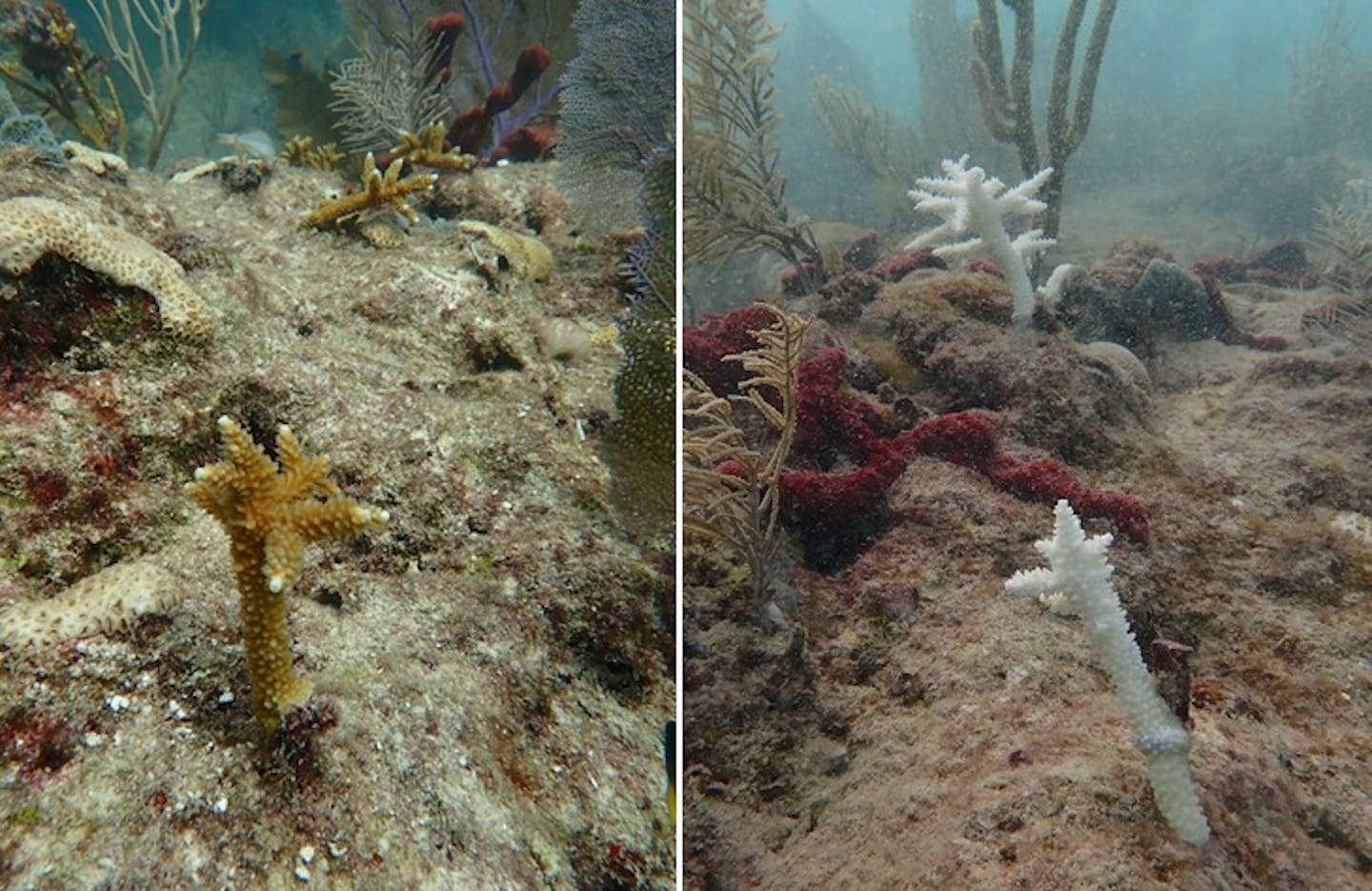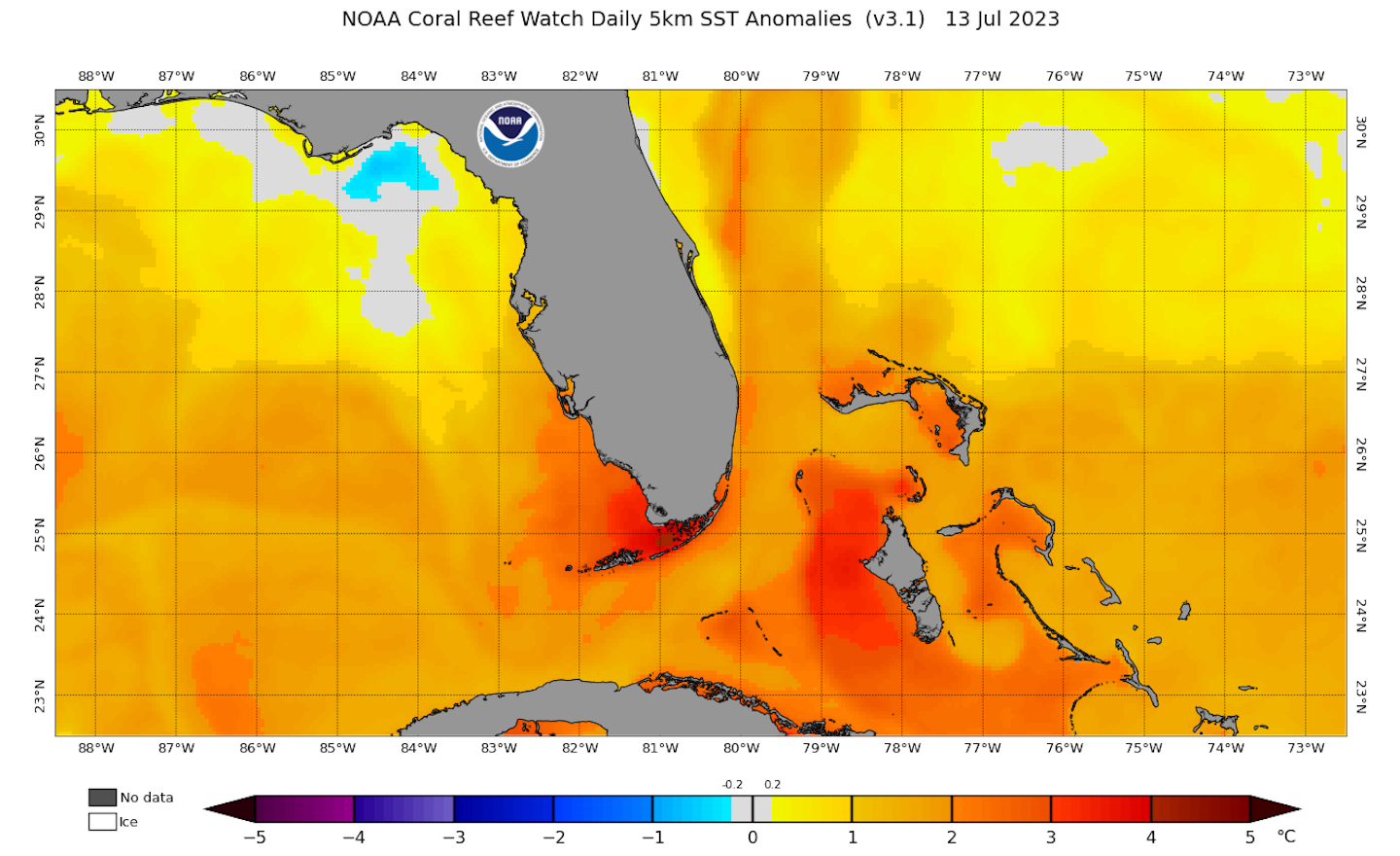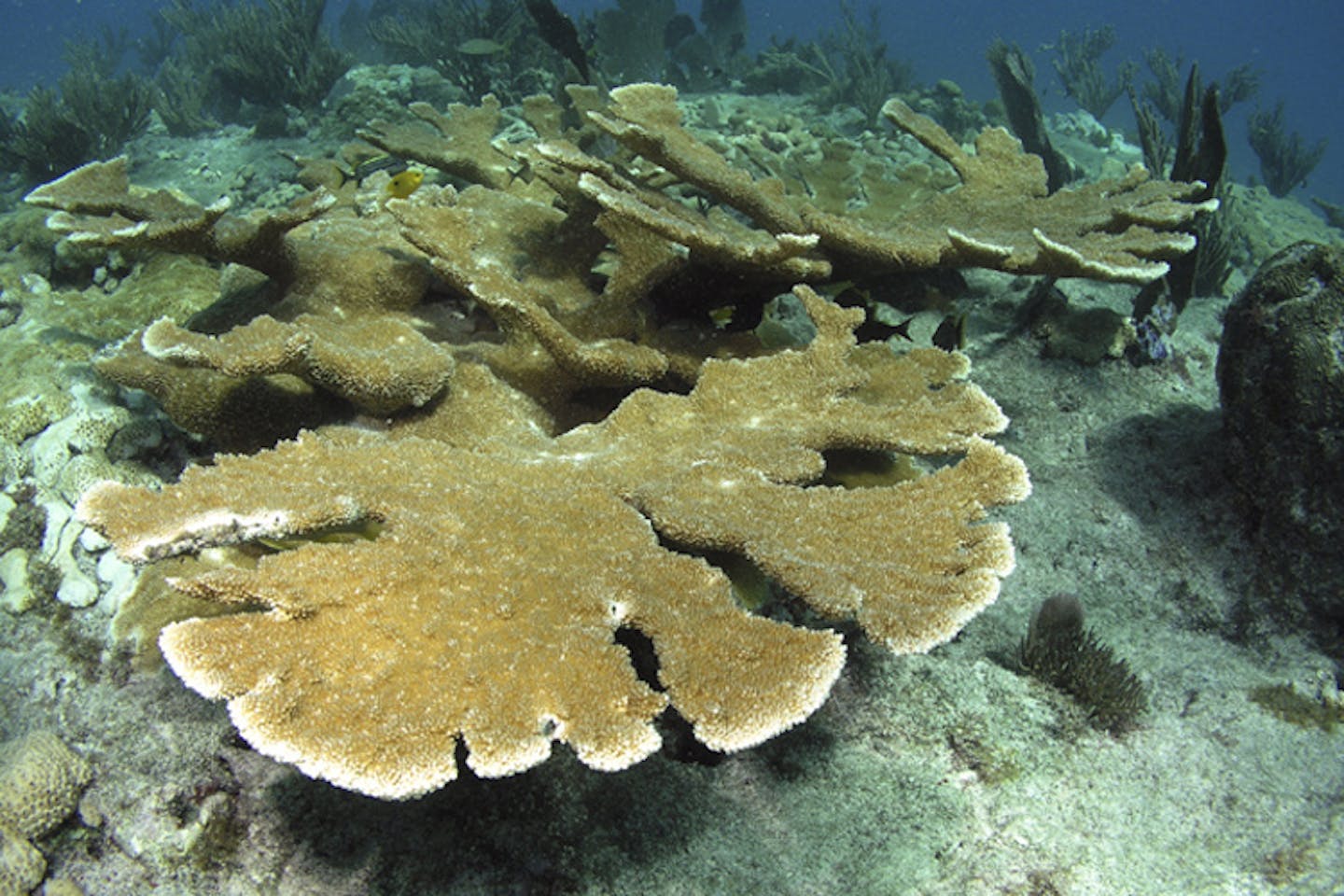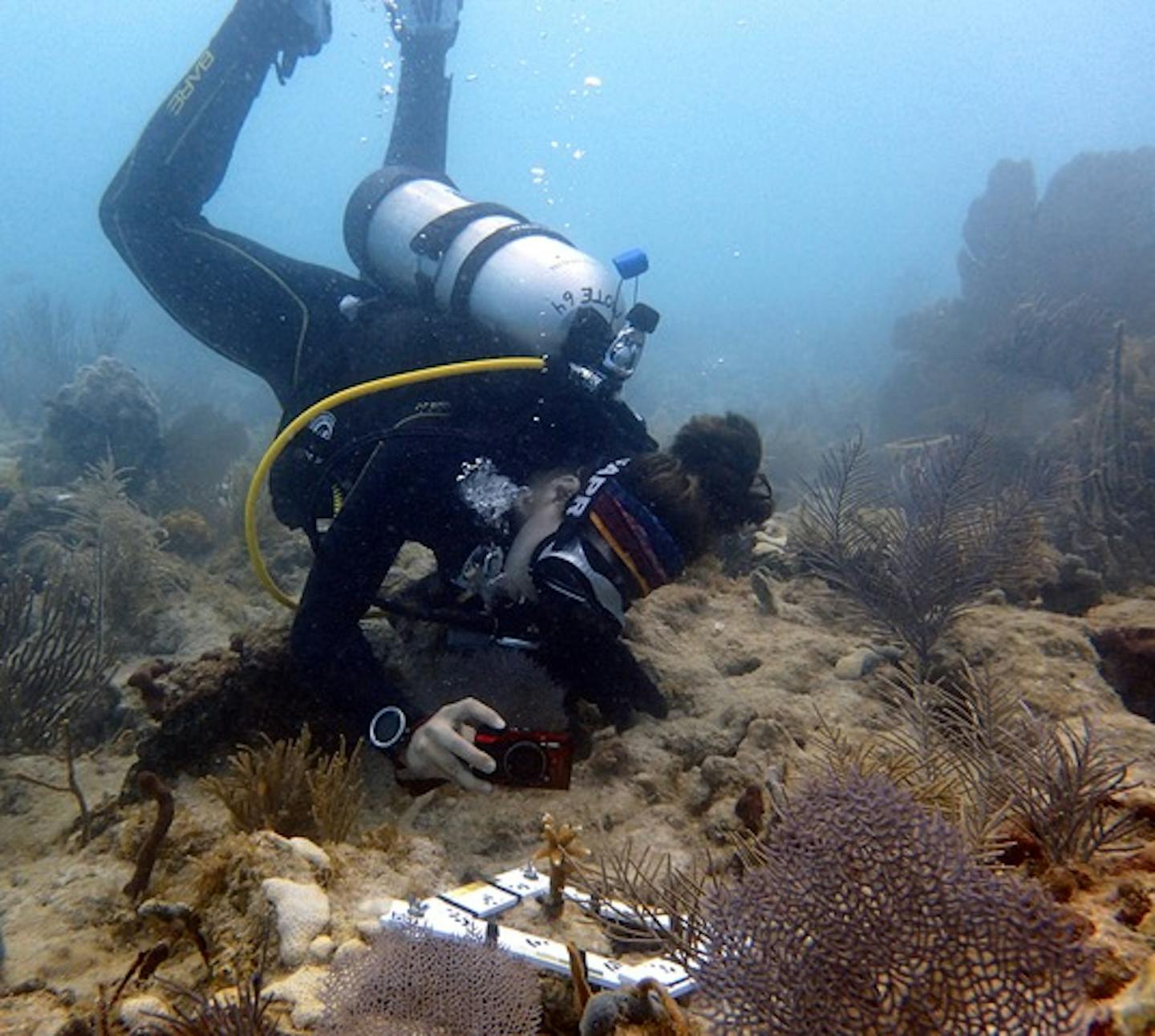
In early June 2023, the coral reefs in the lower Florida Keys and the Dry Tortugas were stunning. We were in diving gear, checking up on hundreds of corals we had transplanted as part of our experiments. The corals’ classic orange-brown colors showed they were thriving.
Just three weeks later, we got a call – a marine heat wave was building, and water temperatures on the reef were dangerously high. Our transplanted corals were bleaching under the heat stress, turning bone white. Some were already dead.

That was the start of a global mass bleaching event. As ocean temperatures rose, rescuers scrambled to relocate surviving corals to land-based tanks, but the heat wave, extending over 2023 and 2024, was lethal.
In a study published Oct. 23, 2025, in the journal Science, we and colleagues from NOAA, the Shedd Aquarium and other institutions found that two of Florida’s most important and iconic reef-building coral species had become functionally extinct across Florida’s coral reef, meaning too few of them remain to serve their previous ecological role.
No chance to recover
In summer 2023, the average sea-surface temperature across Florida’s reef was above 87 degrees Fahrenheit (31 degrees Celsius) for weeks. We found that the accumulated heat stress on the corals was 2.2 to 4 times higher than it had ever been since modern satellite sea-surface temperature recordings began in the 1980s, a time when those two species – branching staghorn and elkhorn corals – were the dominant reef-builders in the region.

The temperatures were so high in the middle and lower Florida Keys that some corals died within days from acute heat shock.
Everywhere on the reef, corals were bleaching. That occurs when temperatures rise high enough that the coral expels its symbiotic algae, turning stark white. The corals rely on these algae for food, a solar-powered energy supply that allows them to build their massive calcium carbonate skeletons, which we know as coral reefs.
These reefs are valuable. They help protect coastal areas during storms, provide safety for young fish and provide habitat for thousands of species. They generate millions of dollars in tourism revenue in places like the Florida Keys. However, the symbiotic relationship between the coral animal and the algae that supports these incredible ecosystems can be disrupted when temperatures rise about 2 to 3 degrees Fahrenheit (1 to 2 degrees Celsius) above the normal summer maximum.
By the end of summer 2023, only three of the 200 corals we had transplanted in the Lower Keys to study how corals grow survived.
In the Dry Tortugas, corals’ bone-white skeletons were already being grown over by seaweed. That’s a warning sign of a potential phase shift, where reefs change from coral-dominated to macroalgae-dominated systems.
Our colleagues observed similar patterns across the Florida Keys: Acroporid corals – staghorn and elkhorn – suffered staggering levels of bleaching and death.
Of the more than 50,000 acroporid corals surveyed across nearly 400 individual reefs before and after the heat wave, 97.8% to 100% ultimately died. Those farther north and offshore in cooler water fared somewhat better.
But this pattern of bleaching extended to the rest of the Caribbean and the world, leading NOAA to declare 2023-2024 the fourth global bleaching event. This type of mass bleaching, in which stress and mortality occur almost simultaneously across locations around the world, points to a common environmental driver.

In the summer of 2023, that environmental driver was clearly soaring water temperatures caused by climate change.
Becoming functionally extinct
Even before the 2023 marine heat wave, staghorn and elkhorn numbers had been dwindling, with punctuated declines accelerated by a diverse array of stressors – hurricane damage, loss of supporting herbivore species, disease and repeated bleaching.
The 2023-2024 event was effectively the final nail in the coffin: The data from our new study shows that these species are now functionally extinct on Florida’s coral reef.
Caribbean acroporids have not entirely disappeared in Florida, but those left are not enough to fulfill their ecological role. When populations become too small, they lose their capacity to rebound – in conservation biology this is known as the “extinction vortex.” With so few individuals, it becomes harder to find a mate, and even when one is found, it’s more likely to be a relative, which has negative genetic consequences.


For an ecosystem-builder like coral, many individuals are required to build an effective reef. Even if the remaining corals were the healthiest and most thermally tolerant of the bunch – they did survive, after all – there are simply not enough of them left to recover on their own.
Can the corals be saved?
Florida’s acroporids have joined the ranks of the California condor – they cannot recover without help. But unlike the condor, there are still pockets of healthy corals scattered throughout their broader range that could be used to help restore areas with localized extinctions.
The surviving corals in Florida could be bred with other Caribbean populations to boost their numbers and increase genetic diversity, an approach known as assisted gene flow.

Advancements in microfragmentation, a way to speed up coral propagation by cutting them into smaller pieces, and cryopreservation, which involves deep-freezing coral sperm to preserve their genetic diversity, have made it possible to mass produce, archive and exchange genetic diversity at a scale that would not have been possible just 10 years ago.
Restoration isn’t easy, though. From a policy perspective, coordinating international exchange of endangered species is complex. There is still disagreement about the capacity to scale up reef restoration to recover entire ecosystems. And the question remains: Even if we could succeed in restoring these reefs, would we be planting corals just in time for the next heat wave to knock them down again?
This is a real risk, because ocean temperatures are rising. There is broad consensus that the world must curb the carbon emissions contributing to increased ocean temperatures for restoration to succeed.
Climate change poses an existential threat to coral reefs, but these advancements, in concert with effective and timely action to curb greenhouse gas emissions, could give them a fighting chance.
This article is republished from The Conversation, a nonprofit, independent news organization bringing you facts and trustworthy analysis to help you make sense of our complex world. It was written by: Carly D. Kenkel, University of Southern California; Jenna Dilworth, University of Southern California, and Maya Gomez, University of Southern California
Read more:
- The heroic effort to save Florida’s coral reef from extreme ocean heat as corals bleach across the Caribbean
- Watching a coral reef die as climate change devastates one of the most pristine tropical island areas on Earth
- Coral reefs face an uncertain recovery from the 4th global mass bleaching event – can climate refuges help?
Carly D. Kenkel has received funding from NSF, NOAA, The Paul G. Allen Frontiers Group, the Mary Gard Jameson Foundation and the Alfred P. Sloan Foundation. She serves on the Genetics Working Group of the Coral Restoration Consortium, the US Acropora Recovery Implementation Team and the Intervention Risk Review Group for Australia’s Great Barrier Reef Restoration and Adaptation Program.
Maya Gomez is affiliated with the Perry Institute for Marine Science.
Jenna Dilworth does not work for, consult, own shares in or receive funding from any company or organization that would benefit from this article, and has disclosed no relevant affiliations beyond their academic appointment.


 The Conversation
The Conversation
 WKOW 27
WKOW 27 CNN Climate
CNN Climate CNN
CNN Arizona Daily Sun
Arizona Daily Sun Associated Press US News
Associated Press US News Reuters US Top
Reuters US Top AmoMama
AmoMama Nola Sports
Nola Sports New York Post Opinion
New York Post Opinion